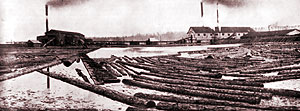|
 
Farm and Forest  History of Forestry
History of Forestry  Grandin Mill
Grandin Mill
The Mill at Grandin
 Life
in the Ozarks at the turn of the century was primitive in most places.
But not in the town of Grandin. Grandin was a mill town. And not
just any mill town. This company-owned lumber town hosted the biggest
sawmill in the United States, for its time. Life
in the Ozarks at the turn of the century was primitive in most places.
But not in the town of Grandin. Grandin was a mill town. And not
just any mill town. This company-owned lumber town hosted the biggest
sawmill in the United States, for its time.
The cities of the Midwest were growing fast, and founders
of the Missouri Lumber and Mining Company had correctly anticipated
the need for lumber to build them. They had soon worked out a way
to harvest, process and ship the vast virgin pine forests of the
deep eastern Ozarks.
Established in 1897, the town of Grandin was named
after the company's largest stockholder, E.B. Grandin. It was wholly
owned by the company, which built homes to house its workers, stores
to supply them, and churches, schools and hospitals to serve them.
More than 475 small frame houses were built to hold families of
various sizes. They rented for $1 per room per month. Many of them
still stand. Large numbers of smaller, starker unpainted shacks
to house single men were also built, and rented for $2 - $2.50 per
month. Most of them have since crumbled into decay. Larger homes
that housed company officials rented for $5 -$10 a month. Many of
them are still standing. Single women were housed in company boarding
houses, for which they paid $18 a month for a room and meals.
By 1909 the great forests were gone, and in 1910 the
company sold the cut-over land, and most of the town, and moved
on. Grandin today is a small town of 235 inhabitants and a tourism
destination for people interested in the history of forestry in
Missouri.
 The
Mill Operation The
Mill Operation
Over the course of the mill's operation, tram lines
(temporary railway lines) were built out into the surrounding forests
as far as Shannon County to move logs directly from forest to mill.
Cut logs in the vast forests were loaded onto the tram cars and
hauled to Toliver Pond, just outside of town. They remained in the
pond for three or four days to soak off any dirt and debris that
might dull or damage a saw blade. From there, the logs were guided
onto a conveyor that lifted them from the pond and into the mill.
There were two mills at Grandin--the big mill and
the little mill. The big one held a circular saw, a band saw and
a gang saw. In one operation, the gang saw could cut a log into
a block and then turn it into dimension lumber. The big mill was
powered by nine boilers that ran three giant steam engines. It produced
160,000 board feet a day.
 The
little mill operated the same way as the big mill, but was powered
by four boilers and one McDonough engine, and contained lath and
shingle mills in addition to the saws. It produced 60,000 board
feet of lumber, 48,000 feet of lath and 28,000 feet of shingles
a day. The
little mill operated the same way as the big mill, but was powered
by four boilers and one McDonough engine, and contained lath and
shingle mills in addition to the saws. It produced 60,000 board
feet of lumber, 48,000 feet of lath and 28,000 feet of shingles
a day.
The reason the mills' output was so great was that
the trees were so large. Many of the logs coming to the mill from
the ancient forests were nearly four feet in diameter. Smaller trees
were considered a waste of time, and no trees less than 11 inches
in diameter were ever taken to the mill. In the photo at right,
the man holds a two-foot measuring stick up to two freshly milled
boards. With a couple of inches to spare, the board he's measuring
is estimated to be about 26 inches wide.

Source: An tour guide of Grandin is available on
the Missouri Department of Conservation web site: http://www.conservation.state.mo.us/forest/cenfore/grandin.htm
Written by Marideth Sisco, from material summarized or reprinted
by permission. Photos from "American Lumberman" magazine, May 1903.
|

